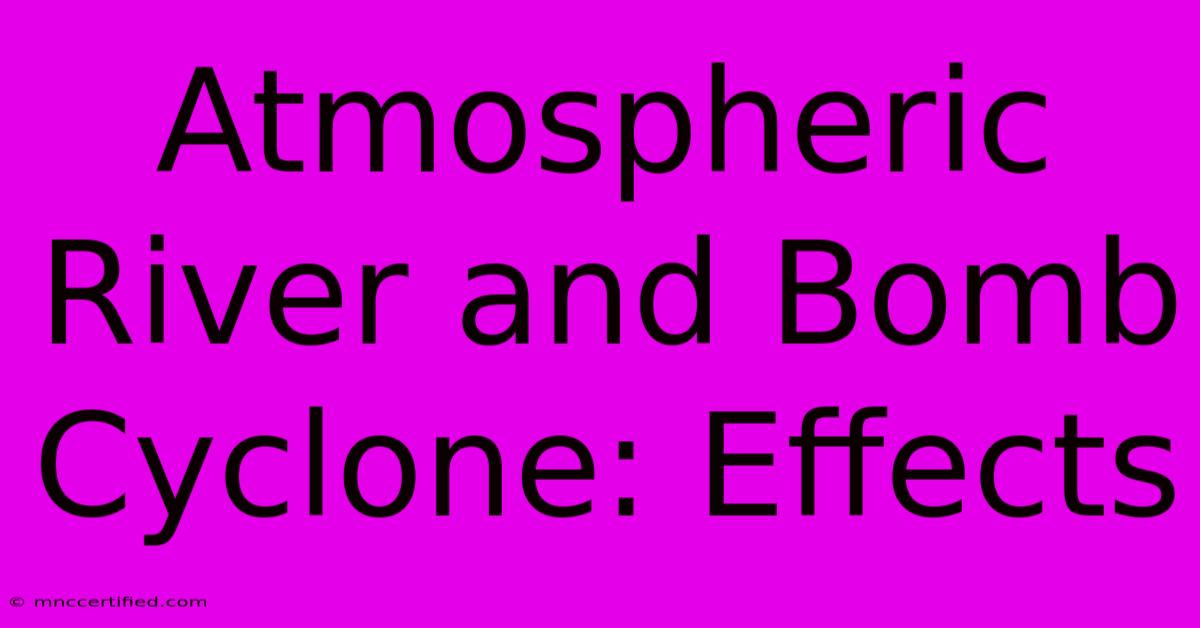Atmospheric River And Bomb Cyclone: Effects

Table of Contents
Atmospheric Rivers and Bomb Cyclones: Devastating Effects and Increased Frequency
Atmospheric rivers (ARs) and bomb cyclones are meteorological phenomena capable of causing significant devastation. While distinct, they can interact, amplifying their destructive potential. Understanding their individual effects and their combined impact is crucial for preparedness and mitigation.
What is an Atmospheric River?
An atmospheric river (AR) is a long, narrow, and transient corridor or filament of concentrated moisture in the atmosphere. Think of it as a river in the sky, transporting vast amounts of water vapor from the tropics and subtropics towards higher latitudes. While ARs are a regular feature of the global atmospheric circulation, their intensity and duration can vary significantly. Intense ARs can deliver torrential rainfall, leading to flooding, landslides, and infrastructure damage. They are responsible for a significant portion of the West Coast's annual precipitation.
Effects of Atmospheric Rivers:
- Flooding: The most immediate and devastating effect is widespread and rapid flooding, often overwhelming drainage systems and causing significant property damage.
- Landslides: Saturated soil loses its stability, leading to landslides, especially in mountainous regions. This can block roads, damage homes, and threaten lives.
- Infrastructure Damage: The sheer volume of water can damage roads, bridges, and other infrastructure, disrupting transportation and essential services.
- Agricultural Losses: Prolonged heavy rainfall can damage crops and livestock, impacting food security and agricultural economies.
What is a Bomb Cyclone?
A bomb cyclone, also known as explosive cyclogenesis, is a mid-latitude cyclone that intensifies rapidly. This rapid intensification is defined by a drop in central pressure of at least 24 millibars in 24 hours. Bomb cyclones are fueled by a strong temperature contrast between warm and cold air masses, creating an unstable atmospheric environment. The rapid pressure drop intensifies winds, driving heavy precipitation and storm surges.
Effects of Bomb Cyclones:
- High Winds: The powerful winds associated with bomb cyclones can cause widespread damage to buildings, trees, and power lines, leading to power outages.
- Coastal Flooding: Storm surges driven by strong winds can cause significant coastal flooding, inundating low-lying areas and eroding coastlines.
- Heavy Snowfall: In colder regions, bomb cyclones can unleash blizzard conditions with heavy snowfall, leading to transportation disruptions and power outages.
- Extreme Cold: The intense cold air associated with some bomb cyclones can lead to hypothermia and other cold-related health issues.
The Combined Impact of Atmospheric Rivers and Bomb Cyclones:
When an atmospheric river coincides with a bomb cyclone, the consequences can be catastrophic. The intense low pressure of the bomb cyclone enhances the moisture transport of the AR, leading to significantly higher rainfall rates and amplified impacts. This combination can result in unprecedented flooding, stronger winds, and more extensive damage.
Examples of Devastating Combined Events:
Several recent events highlight the destructive power of this combination. Researching specific case studies, such as those affecting California and the Northeastern United States, provides valuable insights into the scale of the damage and the challenges of response and recovery.
Increased Frequency and Climate Change:
There is growing evidence suggesting that the frequency and intensity of both atmospheric rivers and bomb cyclones might be increasing due to climate change. Warmer ocean temperatures provide more energy to fuel these systems, potentially leading to more frequent and severe events in the future.
Adaptation and Mitigation Strategies:
Addressing the increasing risks associated with ARs and bomb cyclones requires a multi-pronged approach:
- Improved Forecasting: Advanced forecasting models are crucial for providing timely warnings and enabling proactive measures.
- Infrastructure Improvements: Investing in resilient infrastructure that can withstand extreme weather events is vital.
- Land Use Planning: Careful land use planning can minimize the risk of flooding and landslides.
- Community Preparedness: Educating communities about the risks and developing evacuation plans are essential for reducing casualties.
Understanding the individual and combined effects of atmospheric rivers and bomb cyclones is paramount. By investing in research, improving forecasting capabilities, and implementing effective mitigation strategies, we can better prepare for and reduce the devastating impacts of these powerful weather events.

Thank you for visiting our website wich cover about Atmospheric River And Bomb Cyclone: Effects. We hope the information provided has been useful to you. Feel free to contact us if you have any questions or need further assistance. See you next time and dont miss to bookmark.
Featured Posts
-
Cost Of Endoscopy With Insurance
Nov 21, 2024
-
Car Accident Lawyer No Insurance
Nov 21, 2024
-
Does Glass Claim Raise Insurance
Nov 21, 2024
-
23 28 An Hour Is How Much A Year
Nov 21, 2024
-
Home Insurance Pensacola Florida
Nov 21, 2024